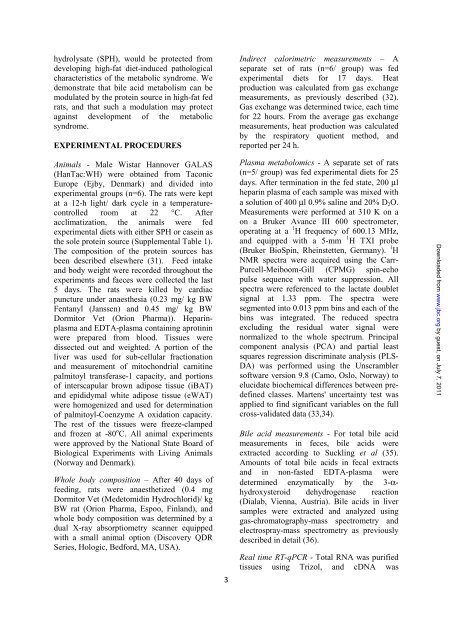The obesogenic effects of polyunsaturated fatty acids are dependent ...
The obesogenic effects of polyunsaturated fatty acids are dependent ...
The obesogenic effects of polyunsaturated fatty acids are dependent ...
Create successful ePaper yourself
Turn your PDF publications into a flip-book with our unique Google optimized e-Paper software.
hydrolysate (SPH), would be protected from<br />
developing high-fat diet-induced pathological<br />
characteristics <strong>of</strong> the metabolic syndrome. We<br />
demonstrate that bile acid metabolism can be<br />
modulated by the protein source in high-fat fed<br />
rats, and that such a modulation may protect<br />
against development <strong>of</strong> the metabolic<br />
syndrome.<br />
EXPERIMENTAL PROCEDURES<br />
Indirect calorimetric measurements – A<br />
separate set <strong>of</strong> rats (n=6/ group) was fed<br />
experimental diets for 17 days. Heat<br />
production was calculated from gas exchange<br />
measurements, as previously described (32).<br />
Gas exchange was determined twice, each time<br />
for 22 hours. From the average gas exchange<br />
measurements, heat production was calculated<br />
by the respiratory quotient method, and<br />
reported per 24 h.<br />
Animals - Male Wistar Hannover GALAS<br />
(HanTac:WH) were obtained from Taconic<br />
Europe (Ejby, Denmark) and divided into<br />
experimental groups (n=6). <strong>The</strong> rats were kept<br />
at a 12-h light/ dark cycle in a temperaturecontrolled<br />
room at 22 °C. After<br />
acclimatization, the animals were fed<br />
experimental diets with either SPH or casein as<br />
the sole protein source (Supplemental Table 1).<br />
<strong>The</strong> composition <strong>of</strong> the protein sources has<br />
been described elsewhere (31). Feed intake<br />
and body weight were recorded throughout the<br />
experiments and faeces were collected the last<br />
5 days. <strong>The</strong> rats were killed by cardiac<br />
puncture under anaesthesia (0.23 mg/ kg BW<br />
Fentanyl (Janssen) and 0.45 mg/ kg BW<br />
Dormitor Vet (Orion Pharma)). Heparinplasma<br />
and EDTA-plasma containing aprotinin<br />
were prep<strong>are</strong>d from blood. Tissues were<br />
dissected out and weighted. A portion <strong>of</strong> the<br />
liver was used for sub-cellular fractionation<br />
and measurement <strong>of</strong> mitochondrial carnitine<br />
palmitoyl transferase-1 capacity, and portions<br />
<strong>of</strong> interscapular brown adipose tissue (iBAT)<br />
and epididymal white adipose tissue (eWAT)<br />
were homogenized and used for determination<br />
<strong>of</strong> palmitoyl-Coenzyme A oxidation capacity.<br />
<strong>The</strong> rest <strong>of</strong> the tissues were freeze-clamped<br />
and frozen at -80 o C. All animal experiments<br />
were approved by the National State Board <strong>of</strong><br />
Biological Experiments with Living Animals<br />
(Norway and Denmark).<br />
Whole body composition – After 40 days <strong>of</strong><br />
feeding, rats were anaesthetized (0.4 mg<br />
Dormitor Vet (Medetomidin Hydrochlorid)/ kg<br />
BW rat (Orion Pharma, Espoo, Finland), and<br />
whole body composition was determined by a<br />
dual X-ray absorptiometry scanner equipped<br />
with a small animal option (Discovery QDR<br />
Series, Hologic, Bedford, MA, USA).<br />
3<br />
Plasma metabolomics - A separate set <strong>of</strong> rats<br />
(n=5/ group) was fed experimental diets for 25<br />
days. After termination in the fed state, 200 µl<br />
heparin plasma <strong>of</strong> each sample was mixed with<br />
a solution <strong>of</strong> 400 µl 0.9% saline and 20% D 2 O.<br />
Measurements were performed at 310 K on a<br />
on a Bruker Avance III 600 spectrometer,<br />
operating at a 1 H frequency <strong>of</strong> 600.13 MHz,<br />
and equipped with a 5-mm 1 H TXI probe<br />
(Bruker BioSpin, Rheinstetten, Germany). 1 H<br />
NMR spectra were acquired using the Carr-<br />
Purcell-Meiboom-Gill (CPMG) spin-echo<br />
pulse sequence with water suppression. All<br />
spectra were referenced to the lactate doublet<br />
signal at 1.33 ppm. <strong>The</strong> spectra were<br />
segmented into 0.013 ppm bins and each <strong>of</strong> the<br />
bins was integrated. <strong>The</strong> reduced spectra<br />
excluding the residual water signal were<br />
normalized to the whole spectrum. Principal<br />
component analysis (PCA) and partial least<br />
squ<strong>are</strong>s regression discriminate analysis (PLS-<br />
DA) was performed using the Unscrambler<br />
s<strong>of</strong>tw<strong>are</strong> version 9.8 (Camo, Oslo, Norway) to<br />
elucidate biochemical differences between predefined<br />
classes. Martens' uncertainty test was<br />
applied to find significant variables on the full<br />
cross-validated data (33,34).<br />
Bile acid measurements - For total bile acid<br />
measurements in feces, bile <strong>acids</strong> were<br />
extracted according to Suckling et al (35).<br />
Amounts <strong>of</strong> total bile <strong>acids</strong> in fecal extracts<br />
and in non-fasted EDTA-plasma were<br />
determined enzymatically by the 3-αhydroxysteroid<br />
dehydrogenase reaction<br />
(Dialab, Vienna, Austria). Bile <strong>acids</strong> in liver<br />
samples were extracted and analyzed using<br />
gas-chromatography-mass spectrometry and<br />
electrospray-mass spectrometry as previously<br />
described in detail (36).<br />
Real time RT-qPCR - Total RNA was purified<br />
tissues using Trizol, and cDNA was<br />
Downloaded from www.jbc.org by guest, on July 7, 2011
















